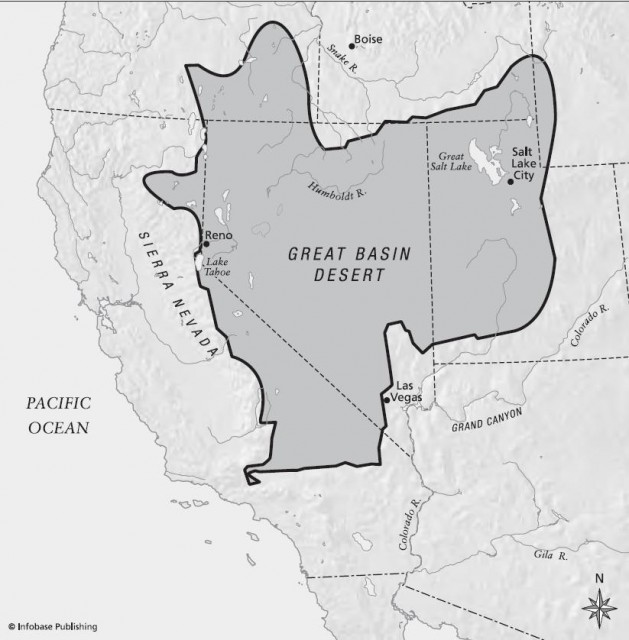Adapted to the Sagebrush Ocean
The Great Basin Desert harbors far fewer species than the warm, summer-rain-blessed Sonoran Desert to the south. Only a handful of flowers like the plains daisy and the yellow parsley bloom in the spring. Only a handful of birds, notably the horned lark, flit through its expanses. Horned larks account for almost all the flocks of birds winging through the sagebrush. They build their nests on the ground, a necessity here because not a single tree rises from this great sagebrush ocean for miles at a stretch. Some populations of horned larks build a crude nest on the ground, carefully putting pebbles or mud pellets to one side to create a flat, smoothly fitted pavement, for reasons that mystify biologists. Perhaps it is some odd takeoff on other populations of horned larks who build little walls of such pebbles, which appear to function as a windbreak.
The chilled soil lacks the organic debris and nutrients that normally fuel plant growth. Fortunately, the struggling plants of the Great Basin get help from mosses and lichens, which grow on their roots and create a spidery network of connections in the soil. The lichens put out threads that bind to the bits of dirt in the soil. The treaded filaments knit together the soil, which reduces erosion by the relentless wind. Other components of alga and fungus that live on the roots draw nutrients from the plants and pay their way by producing free nitrogen, a vital element for plant growth. This microscopic community in the soil is vital for the survival of most plants, which explains why dune buggies, cattle, and anything else that breaks up the soil and snaps these microscopic connections leave scars that persist for decades.

The black-tailed jackrabbit is one of the most important and exquisitely adapted creatures of this sagebrush universe. These jackrabbits inhabit every desert of North America, but are especially important in the harsh conditions of the Great Basin. With a family history that stretches back 20 million years, the jackrabbits love to nibble grass and flowers, but they also have cast-iron digestive systems that can handle even the oils in the leaves of the sagebrush. Even more impressive, they can dine on creosote leaves, which are actually poisonous to most other animals. When it is hot, jackrabbits can cool themselves by circulating blood through ears that account for a fifth of their body length. They can cover 15 feet (5 m) in a bound and reach speeds of 35 miles (56 km) an hour. With eyes mounted on the sides of their heads, they have an almost 360-degree field of vision, which makes it impossible to sneak up on them. They often gather in social groups of 20 or more on moonlit nights, where they court their mates with displays of ecstatic jumping about, complete with sprays of hormone-laced urine. In addition, the jackrabbits unwillingly support the desert's coyotes, hawks, eagles, and other predators.
Another remarkably adapted desert creature is the Great Basin spadefoot toad, an amphibian whose tadpoles must grow up in water in a land with few permanent lakes, rivers, or streams that also freezes every winter. The toads manage this remarkable feat by spending most of their lives buried deep in the dirt, scooping out their burrow by rotating their bodies as they push with first one foot, then the other, and digging with the bony flange of skin on the side of their foot from which they earn their names.
While their cousins in warmer deserts may emerge during summer rains to lay their eggs in temporary pools of water, the Great Basin spadefoot toad must rely on scattered, permanent springs. They spend most of the year hidden in their burrows, waiting for warmer weather. They can store water totaling a third of their body weight, sometimes creating a cocoon of mud to reduce water loss through their skin. When awakened by a heavy rain when the air temperature is above 52°F (11°C), the frogs emerge to unleash a deafening chorus to attract a mate. If they are successful, they lay their eggs in the few permanent springs and the eggs hatch and the tadpoles develop with great speed to take advantage of their narrow climatic window of opportunity.